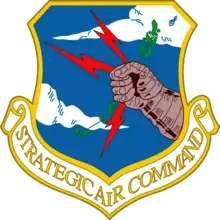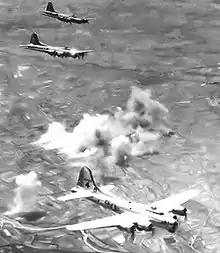352d Bombardment Squadron
The 352d Bombardment Squadron is an inactive United States Air Force unit. It was last assigned to the 301st Bombardment Wing, stationed at Lockbourne Air Force Base, Ohio, where it was inactivated on 8 June 1964.
352d Bombardment Squadron
 | |
|---|---|
 301st Wing B-47 Stratojet[note 1] | |
| Active | 1942–1945; 1946–1964 |
| Country | |
| Branch | |
| Role | Bombardment |
| Part of | Strategic Air Command |
| Motto(s) | Determined[1] |
| Engagements |
|
| Decorations |
|
| Insignia | |
| Patch with 352d Bombardment Squadron emblem (approved 12 June 1957)[1] |  |
During World War II, the 352d Bombardment Squadron was a B-17 Flying Fortress squadron, assigned to the 301st Bombardment Group, Fifteenth Air Force. It earned two Distinguished Unit Citations. The first in 1943, the second in 1944.
The squadron later earned the Air Force Outstanding Unit Award for the period covering 1 January 1961 to 31 December 1962.
History
World War II
Established as a Boeing B-17 Flying Fortress heavy bombardment squadron in early 1942; trained under Second Air Force. Flew antisubmarine patrols off the California coast from late May to early June 1942, then over the Mid-Atlantic coast during June–July 1942.

Deployed to European Theater of Operations in August 1942, being assigned to VIII Bomber Command, one of the first B-17 heavy bomb squadrons assigned to England. Engaged in strategic bombardment operations over Occupied Europe attacking enemy military and industrial targets. Reassigned to Mediterranean Theater of Operations as part of Operation Torch invasion of North Africa. Assigned to Twelfth Air Force and operated from desert airfields in Algeria and Tunisia during North African and Tunisian campaign. Assigned to Northwest African Strategic Air Force during Invasion of Sicily and later Italy in 1943. Allocated to Fifteenth Air Force for strategic bombing of Nazi Germany and occupied Europe. Attacked enemy targets primarily in the Balkans; Southern France; Southern Germany and Austria from southern Italy; engaged in shuttle bombing missions to airfields in the Soviet Union during the summer of 1944.
Personnel largely demobilized after German capitulation in May 1945; squadron reassigned to the United States and was programmed for conversion to B-29 Superfortress operations and deployment to Pacific Theater, plans canceled after Japanese capitulation in August 1945. Aircraft sent to storage and unit inactivated largely as a paper unit in October 1945.
Strategic Air Command

Reactivated in 1946 as a Strategic Air Command Boeing B-29 Superfortressstrategic bombardment squadron. Deployed to Fürstenfeldbruck AB, Germany, July–August 1948; to RAF Scampton, England, October 1948-January 1949; and to RAF Stations Lakenheath and Sculthorpe, May–November 1950 for "show of force" missions in Europe as a result of the Berlin Blockade by the Soviet Union and rising Cold War tensions in Europe. Squadron deployed to Far East Air Forces in February 1951, flying combat missions over North Korea; attacking strategic industrial and military targets during the Korean War.
Returned to the United States in June 1952 and transitioned to the Boeing B-47 Stratojet with the removal of the B-29 as a combat aircraft from the inventory. Moved to Lockbourne AFB in 1958. Added Electronic Countermeasures as an ancillary mission in 1961.
Unit was inactivated and closed in 1964 with the fleet-wide retirement of the B-47 aircraft.
Lineage
- Constituted as the 352d Bombardment Squadron (Heavy) on 28 January 1942
- Activated on 3 February 1942
- Redesignated 352d Bombardment Squadron, Heavy c. 20 August 1943
- Re-designated 352d Bombardment Squadron, Very Heavy on 5 August 1945
- Inactivated on 15 October 1945
- Activated on 4 August 1946
Assignments
- 301st Bombardment Group, 3 February 1942 – 15 October 1945
- 301st Bombardment Group, 4 August 1946 – 16 June 1952 (attached to 301st Bombardment Wing 10 February–20 September 1951, after 20 December 1951)
- 301st Bombardment Wing, 16 June 1952 - 8 June 1964[2][4]
Stations
|
|
Aircraft
- Boeing B-17 Flying Fortress, 1942–1945
- Boeing B-29 Superfortress, 1946–1952
- Boeing B-47 Stratojet, 1958-1961
- Boeing EB-47, 1961-1964[2]
References
- Notes
- Aircraft is Lockheed-Marietta B-47E-LM Stratojet serial 53-1830 parked at Langley Air Force Base.
- Taken as the aircraft left the ball bearing works at Turin, Italy badly damaged in the wake of their attack on 24 July 1944.
- Aircraft is Boeing B-29A-40-BN Superfortress serial 44-61640. Taken at Smokey Hill AFB, Kansas, 1948.
- Citations
- Maurer, Combat Squadrons, pp. 436-437
- Lineage, including assignments, aircraft and stations, through 1963 in Maurer, Combat Squadrons, pp. 436-437
- See Ravenstein, pp. 144-146 (assignment to 301st Wing ended).
- Ravenstein, pp. 144-146
- Station number in Anderson.
Bibliography
![]() This article incorporates public domain material from the Air Force Historical Research Agency website http://www.afhra.af.mil/.
This article incorporates public domain material from the Air Force Historical Research Agency website http://www.afhra.af.mil/.
- Maurer, Maurer, ed. (1983) [1961]. Air Force Combat Units of World War II (PDF) (reprint ed.). Washington, DC: Office of Air Force History. ISBN 0-912799-02-1. LCCN 61060979. Retrieved December 17, 2016.
- Maurer, Maurer, ed. (1982) [1969]. Combat Squadrons of the Air Force, World War II (PDF) (reprint ed.). Washington, DC: Office of Air Force History. ISBN 0-405-12194-6. LCCN 70605402. OCLC 72556. Retrieved December 17, 2016.
- Ravenstein, Charles A. (1984). Air Force Combat Wings, Lineage & Honors Histories 1947-1977. Washington, DC: Office of Air Force History. ISBN 0-912799-12-9. Retrieved December 17, 2016.